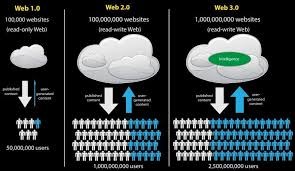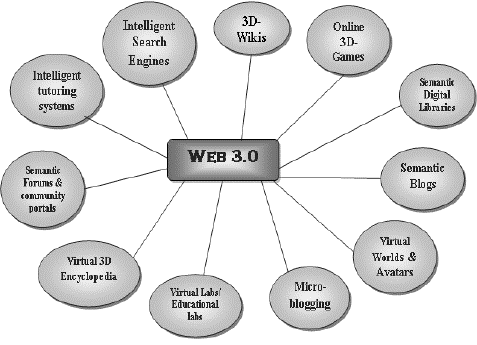Digital Lessons from Silicon Valley

The next level: Web 3.0
Amsterdam, January 20, 2021– At a recent Zoom conference, Humphrey Polanen from Palo Alto, the heart of California’s Silicon Valleypatiently explains that traditional and ordinary websites have had their day and are far outdated.

Web1.0 is from twenty, twenty-five years ago,” he says, “a relic and dinosaur of the 1990s. If you want to keep abreast of the developments around the web, you have to look beyond and continuously improve your digital knowledge. brush up.”
As a leading expert on digital developments, this Sranangman from Paramaribo should know. His entrepreneurship and history in the digital world is attracting worldwide attention. His future even more.
The time of at consumers aimed web pages and searching the internet is not over yet, but ageing. Web 2.0 started pretty much after the disastrous dot com crisis of 2000/2001, when mountains of gold were promised, but nobody had the chance to spend their money on the internet yet.
The main features of Web 2.0 are the interaction, such as social media, and the possibility to spend money in virtual and digital shops and entertainment companies or to provide high-quality information.
Web 3.0 has actually already started and has flattened the layer that is being added with blockchain, cryptocurrencies and non-fungible tokens, or NFTs, and the underlying smart contracts. In short; digital and decentralized possession.

In fact, the Web 3.0 revolution and globalization has been facilitated by the decentralized nature of the Internet itself. It is the internet that is breaking free from the traditional currencies that are held in check by governments and central banks.
These are being replaced by cryptocurrencies and digital decentralized ledgers that are kept in the air by anonymous computers that all work together on the basis of open source software without a central controller in between.
The future is in fact already here, only not everyone has it yet, except for a few who want to share this knowledge with eyesonsuriname.
Web 3.0
Transfer money to someone else without a bank or central party
On web 3.0 you can transfer virtual money worldwide to someone else without a bank or central party in between. Suppose you are an entrepreneur or musician and make music or start a company that a growing group of people like.
Then you can buy the virtual rights to such a music number or company and support the entrepreneur or artist. But if you resell that right, it can be arranged in such a way that the musician also receives virtual money for this. People prefer to always write virtually here, because anyone can copy the music and as an owner you cannot enforce your rights on the ‘old’ world.

It’s more that you can demonstrate that you’ve bought the right to the song from the original artist and that people can verify it, but it’s still based on trust.
Suppose the artist embraces a different system for tokens or sells his rights again, then there is little you can do about this. On the other hand, if the artist does that, they will lose the trust of the crowd and will not be able to earn anything from their tokens. Here’s another example. A popular game may associate unique items from that game, such as a magic sword, with a unique token associated with the game. Whoever has the token can use the sword in the game.

The buying and selling of this sword is done in a way that is separate from banks and the price can be virtual coins, but also cryptocurrencies that can be converted into euros or dollars somewhere. This is a nice bridge to the second subject; metaverse.Second lifeDo you remember the virtual world from second life?
That was a virtual world in which you could move with your own avatar and interact with other avatars. A virtual world that was finite. So you could buy ‘land’ and a city in America was building the first virtual city hall in 2007.

Second life, however, was a central business and the virtual tokens were a counter in the game and had no relationship with the world outside. What was also not in second life was that you could really immerse yourself in that world with VR glasses.
Let Meta now make the best-selling VR goggles of all time: the Oculus Quest. With this setup you can play games, but you can also design your own avatar and fill a house with stuff you’ve earned from interaction. Poker players have played a few games of poker with people from all over the world and that was quite special.
You not only hear and see the people sitting around the table, but also see the movements of their hands and their heads. So you can give a high five that vibrates in your hands.Metaverse”There is not one owner with all control”What exactly the metaverse is, nobody knows. It’s a vision, an idea. What it does seem like is that it could be some kind of alternate reality
Metaverse
There is not one owner with all control
Nobody knows exactly what the metaverse is. It’s a vision, an idea. What it does seem like is that it can become a kind of alternate reality where anyone can be anything. And that you don’t have to be together physically to experience it together. What it seems is that it is not all just animation like with VR glasses. It brings together elements of the physical world in a virtual world. For example, you can go to the cinema or concert together where you can be really close to your idol and each other, but also play a game together in a fantasy world.
In addition, Mark Zuckerberg of Facebook/Metaverse suggests that it is a universe for everyone and not just Meta. So that a kind of framework is created in which you can connect various possibilities and that there is not one owner with all control. But that’s just a theory.
Bringing web 3.0 and metaverse together creates an alternate reality in which the exchange of items is done in a virtual way but using your identity. By digitally signing something, you can prove that something belongs to you or comes from you. It can also make the objects you share unique, but this is the dream you will be sold.
The Future
The development of VR/AR technology is accelerating, but the big breakthrough may not happen in the next five years. This fits in perfectly with the idea that the short term is overestimated and the long term is underestimated.
What does not change, however, is the desire for money and power. He who has much will get much more in both money and power. For convenience and entertainment, many will not really bother with this.

They buy into this fantasy. Privacy or centralization is not something the majority is concerned with. So bread and games. There are many snags to web 3.0 and the metaverse. Who all store data about you? And is this done safely?
Digital signing or exchanging tokens may be done on the basis of cryptography, but if you lose the key or are stolen, you immediately lose control.
So it is not a good authentication.
If you become a victim of a crime, where can you get your rights? In systems with people and money, regulation is simply necessary. How can the essential trias politica, the separation between legislation, justice and enforcement, be maintained? Next level dystopia”Inequality, intolerance and abuse of power”Experience shows that something arises first and only years later proper regulation is introduced. In this world where facts are only seen as opinions, the metaverse has the perfect storm of anarchy and division.
Web 3.0 and metaverse are human inventions. Nevertheless, they have in common that it is both virtual and contrasts with the reality of the physical world as we have it today. They share a promise of innovation and endless possibilities, but the reality doesn’t change. Inequality, intolerance and abuse of power, with web 3.0 and metaverse it shoots to the next but unknown step. Nevertheless, we will have to learn to live with it, for there is no reason why it will not come into existence.










One Response
Web 3.0 comes with promising new features. While Humphrey Polanen from Palo Alto explains why new virtual reality tools turn traditional websites obsolete, fears of a dystopian future arise, where people are locked into an artificial reality and lose contact with physical reality.